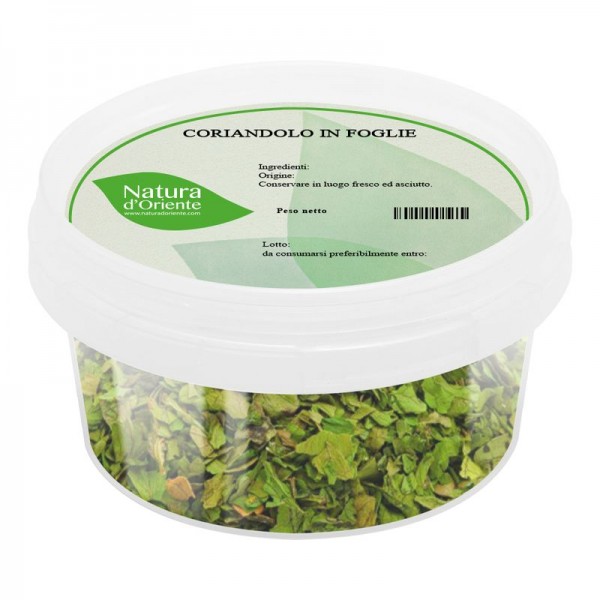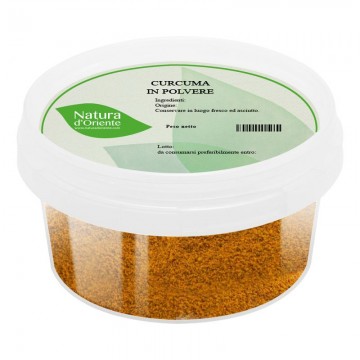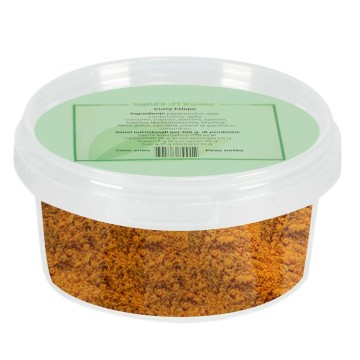As an aromatic herb, it is commonly used to flavor many different international cuisine dishes. Whole dried coriander leaves are used to give an intense aroma to soups and sauces, and a typical pungent and citrusy taste (different from the flavor of the seeds).
Coriander leaves: properties and benefits
Coriander can facilitate digestive function and gastrointestinal regularity, reducing unpleasant symptoms such as bloating due to excess gas. The essential oils contained in coriander can contribute to the correct secretion of enzymes and juices in the stomach, thus stimulating the assimilation of food and the correct movements of the digestive tract. Components such as linalool and limonene can promote the correct functioning of the intestine, with useful purposes for relieving diarrhea, nausea and gastric disorders. A herbal tea with coriander leaves can facilitate the elimination of abdominal and intestinal gas, avoiding flatulence and bloating. Usually about 2.5 g of dried coriander is used, infused for about 5-7 minutes in a cup of boiling water (about 100 °C). Coriander is rich in antioxidants such as terpinene, quercetin and tocopherols, which are beneficial for the well-being of our cells: they help protect them from damage caused by free radicals. Coriander can act on carbohydrate metabolism, activating some enzymes that help regulate the correct assimilation and absorption of sugars; consequently, their level in the blood. For this reason, people with low blood sugar should use cilantro with caution. Pregnant women are also advised to be careful when taking coriander leaf herbal teas.
This herb has many vitamins and minerals, including iron, magnesium, manganese, copper. Coriander leaves can be a good source of fiber, they have essential oils and acids with beneficial properties.
The use of coriander leaves in cooking
Widely used as a spice, they are a typical ingredient of Asian cuisine, Indian and Middle Eastern, where they are used together with stems as "dhaniya". The leaves give the kitchen the flavor profile of a strong, refreshing and citrusy herb, with a slight hint of lemon and fruitiness. They recall the flavor and aroma of dill, cumin and fennel.
Savory recipes: coriander leaves are often used to flavor soups, broths, rice and broth. Also excellent with legumes, in lentil and chickpea soups. They give a fresh flavor to roasted vegetables, mushrooms, fried foods and egg dishes. A handful of coriander leaves are ideal for garnishing cold pasta salads and adding a rich twist to feta cheese. They are tastefully used in sandwich fillings.
International cuisine: coriander leaves are a typical tasty addition in exotic dishes such as curry, masala, Thai noodles. They are used in felafel and Middle Eastern couscous, as well as in Mexican recipes such as white bean chili (chopped together with chili pepper) and tacos.
Meat: coriander leaves can give an intense taste to meat and fish dishes, in particular game and shellfish, on meatballs. You can use coriander in barbecue rubs by adding it to other spices, especially to enhance the flavor of chicken and white meats.
Sauces: excellent ingredient for fresh tomato sauces, mixes well with garlic, peanuts and lemon juice to obtain sauces and marinades. Its flavor is popular in Mexican and South American sauces such as guacamole, chimichurri and ranchera sauce for eggs.
Coriander must be dosed carefully as it can cover the flavor of the dishes. Furthermore, in excess, it has a note that can remind some people of soap. This appears to be due to the aldehydes (organic compounds) in the leaves, which some perceive in this way by their smell and taste receptors. To make a difference in a dish, even just ¼ teaspoon of coriander leaves is enough.
Barley salad with chimichurri Ingredients: parsley 30 g - coriander 60 g - chopped red onion 75 g - 3 cloves of garlic - 2 tablespoons of lime juice - red wine vinegar 60 ml - ¼ teaspoon of salt - ¼ teaspoon of pepper - ¼ teaspoon of crushed red pepper - extra virgin olive oil 120 ml - feta cheese 75 g - raw barley 220 g - fresh spinach 60 g Preparation > Bring 500ml of water to the boil and add the barley. Cook 7 to 10 minutes, or until al dente (doneness may vary; check the orzo packaging). While the orzo cooks, add to a food processor: parsley, cilantro, red onion, garlic, lime juice, aclass of red wine, salt, black pepper, red pepper and olive oil. Blend until smooth. Slice the spinach into thin strips and set aside. Once the barley has been drained, mix to combine the barley and the chimichurri sauce (quantity according to taste). Add the spinach and feta, and serve.
Origins and history of cultivation
Coriander comes from the annual herbaceous plant Coriandrum sativum, of the Apiaceae (or Umbelliferae) family. A family related to parsley, carrots and celery. The plant is native to the Mediterranean and Middle Eastern regions, and evidence of the use of coriander dates back to around 5000 BC. it was used both as an aromatic herb and as a carminative spice. The ancient Romans already used it to flavor bread, and in more recent times it has been used in medicine to mask the unpleasant flavors and odors of some drugs. Today the coriander plant is widely cultivated in many areas of the world to obtain its many edible parts. The dried fruits and seeds are used to flavor various foods, while the delicate leaves are widely used in Indian, Chinese and Latin American cuisine. The edible parts of the Coriandrum sativum plant taste very different. While the seeds exhibit an earthy flavor, coriander leaves are pungent and citrusy, with a hint of soap-like flavor. Although it is also possible to use the stems of the plant in recipes, usually only the coriander leaves that contain the best flavor are chosen, used whole. The fruits have a delicate aroma and a combined flavor between lemon peel and sage. The plant is 30 to 60 cm tall and displays fragrant leaves, small pink or whitish flowers and a small fruit. A curiosity? In the United States, coriander leaves are called cilantro, and are distinguished from the seeds called "coriander". Furthermore, this plant is also known as Chinese parsley.





 No reward points for this product.
No reward points for this product.















